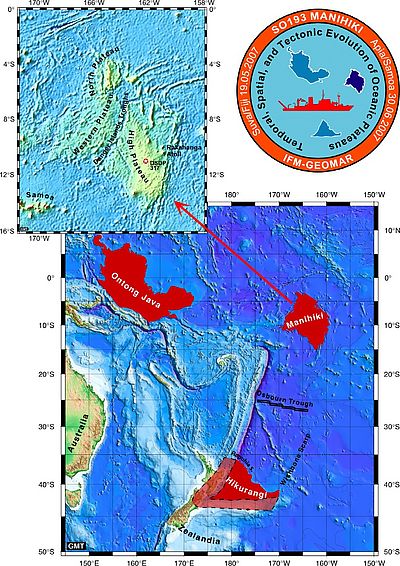The research project SO193 MANIHIKI comprised investigations of volcanic structures, magmatic rocks and marine organism at the submarine Manihiki Plateau in the SW-Pacific. The Manihiki Plateau largely consists of volcanic rocks and is considered as a Large Igneous province (LIP). The geological studies carried out on a cruise with RV Sonne in May/June 2007 focussed on bathymetric mapping and hard rock sampling of all major geomorphological units of the plateau and adjacent seamounts. Subsequent morphological, volcanological, petrological, geochemical, and geochronological analyses aimed to reconstruct the origin and spatial and temporal evolution of the Manihiki Plateau and to characterize the relationship between the Manihiki Plateau and the other LIPs in the western and southwestern Pacific (Ontong Java Plateau off the Solomon Islands and Hikurangi Plateau off New Zealand). SO193 MANIHIKI was based on the results of prior studies (e.g., SO168 ZEALANDIA). The major objectives of the research project were (1) to contribute to a better understanding of LIPs and associated mantle processes, (2) to provide new informations on the origin, extent and effects of the huge Cretaceous magmatic events which caused the formation of LIPs, and (3) to enable a more detailed reconstruction of the geodynamic evolution of the SW-Pacific. Furthermore we wanted to test the hypothesis that the formation of the Manihiki Plateau has been part of the so-called „Greater Ontong Java Plateau Event“. This submarine event occured ~120 Mill. years ago and is the largest-known magmatic event on our planet which may have covered nearly 1% of the Earth’s surface with volcanism. Furthermore representative samples of the deep-sea meio- and macrofauna were used to investigate the diversity and the distributional patterns of the benthic invertebrate communities throughout the Manihiki Plateau. In comparison to results of previous expeditions, the species composition of these communities helped to characterise the Manihiki Plateau as a biodiversity 'hot spot' and a centre of origin for many invertebrate species.
For more detailed informations on the SO193 MANIHIKI research project click here.
Cruise report SO-193 MANIHIKI



